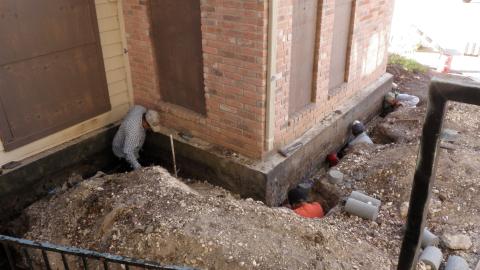
Does a foundation “repair” company really drive down to bedrock?
For starters, this brief article is not intended to discredit reputable foundation leveling companies that are honest about that performance and expectation of there leveling methods or systems for slab on grade foundations. In our previous article titled “Foundation Repair Scams” we discussed that the typical method of using pressed piles should not be considered a method for stabilizing the foundation, as some foundation repair companies claim. The idea of stabilizing the foundation is dependent on the source of the problem. And the source is……….SOIL MOVEMENT. If a pile system is pressed into the soils that are moving then obviously those very same piles are subjected to the same movement and influence of the moving soils. The soils are not selective on who or what they move. Some foundation “repair” companies claim to drive piles to bedrock but it is very rare (or non-existant) to have a geologist or geotechnical engineer on the staff of those companies to verify the depth of the bedrock or if it is attainable. The question then is, “ where is the bed rock” that foundation repair companies claim is throughout San Antonio or Austin.
In 1982 the University of Texas at Austin revised the Geologic Atlas of Texas (http://www.maproomblog.com/2009/06/geologic_atlas_of_texas.php). Referring to the San Antonio sheet of the map (http://www.twdb.state.tx.us/GwRD/GTA/GAT/san%20antonio.htm) the bedrock that foundation repair companies claim is throughout San Antonio is actually north of Loop 410. The area that is shaded in dark green (symbol staring in K) is the infamous bedrock that is near the surface.
If you live near Babcock Road and DeZavala you will notice tan silty clay with cobbles and marl near the surface. Marl is material that can be considered bedrock since it is relatively stable and has a high bearing capacity. If you live near Evans road then you most likely can not dig a post hole without the use of heavy machinery to drill through the hard lithic limestone near the surface. However, if you live anywhere on the map that is tan, pink or orange then you live in an area that has clays, silty clays, sandy silty clay, clay with gravel or gravely clay. The key word there is clay.
Alamo Heights and portions of Converse are special. These areas have calcareous nodules and deposits within the clay. The calcareous adds a lot of benefit to the soils since it acts as a cementing agent and minimizes the soils from expanding with an increase in the moisture content. The downfall of these soils is that they tend to consolidate or settle more as the moisture content is lowered. Hence, settlement of the soils within these areas is more prevent may not rebound as easily as other soils.
For residents in that live along the orange band (Ec) and below, you should have fine sand, sand, sandy loam or clayey sand throughout. The clayey sand should still be considered expansive even if the sand is mixed in with it. The sands and sandy loam should be expected to settle with pressure and moisture but will not expand if water is added.
For the rest of us that live everywhere else without the benefit of lithic bedrock near the surface or calcareous nodules we are being mislead by some foundation repair companies that claim to drive piles all the way down to bedrock. In some instances the resistance that some foundation “repair” companies claim is as hard as rock might actually be a gravelly clay layer. The gravel (some times as big a 2” or 3” in diameter) might be misinterpreted as bedrock.
To really know if bedrock is near the surface you will need a geotechnical study of the soils supporting your house. The study typically runs about $3k to $5k, depending on the total depth and number of locations. The study will classify the soils beneath your house. However, most geotechnical engineering companies will first look at the Geologic Atlas of Texas to understand what types of soils they expect to run into.
Define foundation “repair”?
Having a slab foundation “repaired” implies that it was broken and now it is now repaired. Leveling a foundation should be considered just that, leveling. The system that is used to level the foundation is still subjected to soil movement. Expecting a foundation repair company to stabilize a foundation by pressing cylinders or pipes into the clays is not possible unless the actual clays are stable. The one expectation that you certainly should have is that a foundation with or without press piles will move again.
How long will my foundation be level if I hire a foundation “repair” company?
A common question that we receive is “how long should I expect for my foundation to stay level if I decide to hire a foundation ‘repair’ company to level it”. The answer is, “as long as the moisture content in the soils stay constant”. Since the moisture content in the soils varies and is dependent on a long list of factors you should expect the foundation to start to move immediately. Some of the movement will not be readily obvious but it will occur. The direction of the movement (up or down) is highly unpredictable and subjected to the change in moisture.
- Log in to post comments
